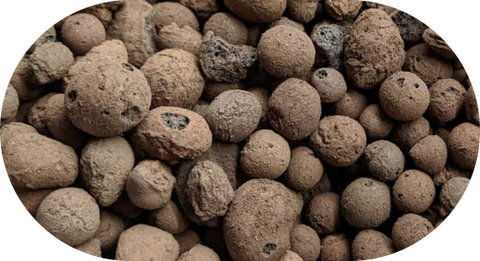Introduction to Hydroponics Part 2

In the last article , we introduced what hydroponics is and how it actually works. In this article, we will focus more on how to care for hydroponic plants, what we need to grow them perfectly and other tips.
What we need for hydroponic growing in home conditions.
For hydroponic cultivation, we need a few essential things. In addition to the plant itself, which must already be adapted for the hydroponic medium (especially the root ball), we need a suitable waterproof cover for the flower pot , in which you will place the hydroponic container , ideally with a hole for a level gauge (water mark). Choose the packaging and container according to the size of your plant. Another element will be the growing medium.
Growing media in the case of hydroponics are special mineral (volcanic) materials that are highly porous and vapor-permeable - they retain moisture and absorb water. In the case of hydroponics, where no media are used, we are only talking about the appropriate use of water, which may or may not circulate in special containers, and the plants are alive from nutrient solutions and specialized fertilizers.
Mineral substrates suitable for hydroponics
Among the most famous hydroponic media are expanded clay, managreen, zeolite, lava stones, pumice, various types of sand, etc. For seedling plants, propagation and cuttings, seedling cubes made of basalt fibers can also be used, which are most often used for propagation and not for long-term maintenance of plants in hydroponics. Let's take a look at the individual components.

CeramsiteThe most common hydroponic growing medium you can find at any plant store. For smaller pots, we recommend getting a smaller grain size. |
 LiaporAn alternative to expanded clay can be Liapor, which is made of the same material. It is just a different brand and shape, which is usually uniformly round. |
 PerliteVery low density amorphous volcanic glass. It contains a large amount of water, therefore it is often used for aerating the soil, from which it will extract excess water. |
 PumiceAn igneous rock made of volcanic glass, which has similar properties to expanded clay and its density is very low, therefore it is very light. |

ZeoliteAn aluminosilicate mineral with a microporous structure with a high ability to absorb points and moisture. |
 ManagreenA specialized hydroponic medium containing a mixture of several types of mineral stones, which in combination are most beneficial for plant growth. |

RockwoolSpecial mineral wool made from glass fibers of volcanic remains. Widely used in plant propagation, because it can be shaped very well, e.g. into planting cubes, which can also be bought already in planting plates. |
 Lava stonesLava rock debris that is created directly from the lava after volcanic eruptions. Its vapor permeability is also very high and is often used in aquariums and for paludariums or florariums. This type of stones can also be purchased in larger sizes as a solitaire. |
Number 1 for beginners is herbs
It might surprise you, but some of the fastest growing plants in hydroponics are herbs. Especially the fleshy and easy-to-care ones, which include, for example, lemon balm, mint, basil, and for the more enthusiastic, salads and vegetables can be grown very well in hydroponics. But it is more difficult to grow such plants in an apartment, so for those of you who have a house or a greenhouse, growing vegetables is easier.
The easiest way to grow herbs is to buy the selected herb in the supermarket. For example, basil. Cut the basil down to the ground, cut off about the last 2-4 leaves so that you have about 5-10 cm of stem without leaves and put all the twigs in water to root. Rooting in herbal plants is very fast, you will usually see it in a week or 14 days in the case of later plants. When the plant has visible roots, move the plant to a suitable container for hydroponics and use the mineral substrate mentioned above. You can also use the so-called "short method" when the plant is only in water, e.g. in a glass container, but the plant is fixed at the top so that it cannot fall into the water and the roots reach down to the water. Don't forget a suitable fertilizer, because herbs "drink" a lot and need nutrients so that you don't have yellowed and unsightly leaves.

Caring for houseplants before planting in hydroponics
If we decided to take our plant, which until now was in a classic substrate, always pay attention to these things:
1. Large plants and plants with a trunk or robust plants such as Ficus benjamina etc. are not suitable for conversion to hydroponics. This is because the bigger the plant, the more susceptible it is to death if you give it such a big shock that you give it when you need to remove the roots from the substrate. Most such plants cannot stand it and the roots begin to rot.
2. The plant should ideally be smaller.
3. The plant should be in good condition and have healthy roots.
4. Do not put plants attacked by pests or frozen in hydroponics and treat them first.
5. Cacti and succulents are probably not suitable for you in hydroponics, and fern-like plants such as Nephrolepis exaltata, Asplenia, etc., do not tolerate the transfer very well.
Caring for houseplants after transplanting (transferring) to hydroponics
The plant that you converted to hydroponic cultivation according to our previous article will have a few weeks of small recovery. The plant needs to get used to the new environment, discard weak roots and, on the contrary, send out new, so-called "water" roots, which are usually pure white. This process takes about a month, depending on the type of plant. It is not unusual for the plant to drop a few leaves in the beginning or for the lower leaves to turn yellow and fall off. The problem arises if the plant is generally yellow or wilted, in which case there is a high probability that your roots are rotting and it would be better to remove the plant from the medium and check the roots. If they are not in order, rinse them well under running water and leave the plant for some time only in water until you feel that the plant is already in order.
Do not fertilize the plant after the transfer, you can use a smaller amount of lignohumate , which will support the roots, do not place the plant in direct sunlight and do not cut the plant. You can also make a beginner's mistake if you immediately place a new plant in a hydroponic container and pour water to the maximum level on the watermark line or even more, which is not desirable. Always maintain the optimum water level and only use it to the maximum when you know you will not be at home for more than a week.

And how do we take care of the hydro room when everything is perfect?
There is nothing simpler. You add water to the plant according to the line that you should have together with the hydroponic growing container. If you somehow made the container yourself, the water should reach about 1/4 of the container. Ideally, we use settled water that does not contain chlorine and other undesirable substances that harm both the roots and the medium, on which they start to form a white coating and, over time, potential mold.
For fertilizing, we use either hydroponic fertilizers (liquid or granular) and if you don't have any at hand, you can also use the classic one, but keep the dosage to a minimum. Avoid contact of the media with the sun's rays, you avoid that you start to develop green algae inside.
Roughly once a month, it is recommended to rinse the substrate with a stream of water and thus wash away fallen roots, dirt, crumbs, etc. from the container. which could rot in the pot, you can also completely change the water.
A final tip
Do you have a calathea or arrowroot at home and are you constantly dealing with dead leaves and the plant is generally unsightly? It causes too dry and warm air, these plants require excessive air humidity, and misting the leaves will unfortunately not be enough for you. In addition to choosing the right place, you can significantly help the plant with hydroponics. When these plants are in hydroponics, the water that evaporates from the pot naturally moistens the plant from below and, in combination with a suitable habitat and light, gives the plant exactly what it needs. But be careful with the water, because both of these plants require more standing water and hard water is not good for them.
Author: Martin Seidl
-
Posted in
Zajímavosti a tipy




